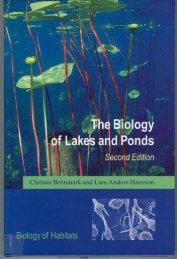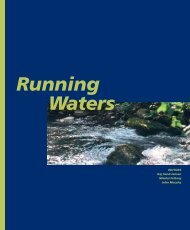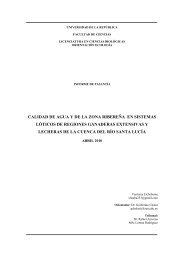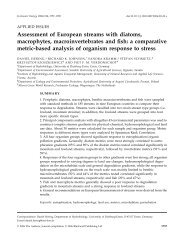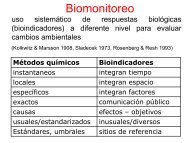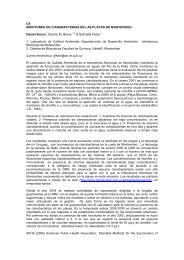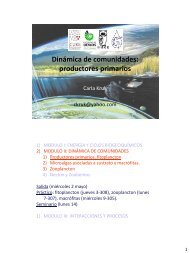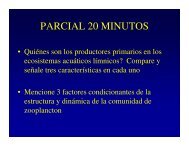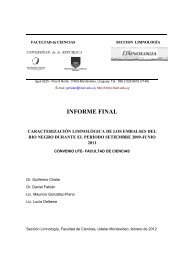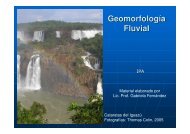Clase-Pigmentos-FITO2010
Clase-Pigmentos-FITO2010
Clase-Pigmentos-FITO2010
You also want an ePaper? Increase the reach of your titles
YUMPU automatically turns print PDFs into web optimized ePapers that Google loves.
Aspectos fisiológicos:<br />
tipos y papel de pigmentos
Cylindrospermopsis raciborskii<br />
Chlorella nivalis
Funciones:<br />
PIGMENTOS<br />
1- FOTOSÍNTESIS Absorción en rango visible de la<br />
radiación solar (principalmente): 400-700nm<br />
2- PROTECCIÓN: Protección frente a altas intensidades de luz<br />
o radiación UV (“quenching”, blanqueadores)<br />
3- RESERVA de nutrientes<br />
<strong>Pigmentos</strong> presentes en el fitoplancton:<br />
1- CLOROFILAS<br />
2- CAROTENOIDES (xantofilas, carotenos)<br />
3- FICOBILINAS<br />
Existen más de 50 pigmentos algales diferentes<br />
(Rowan, 1989, Zapata et al 2004)
PIGMENTOS FOTOSINTETIZADORES:<br />
Clorofila a<br />
<strong>Pigmentos</strong> accesorios o cosechadores (light harvesting):<br />
Clorofilas accesorias: b, c y d<br />
Carotenoides y Ficobilinas<br />
PIGMENTOS FOTOPROTECTORES (disipación de la energía<br />
excesiva)<br />
Carotenoides<br />
Scytoneminas en Cyanobacteria filamentosas (NO en el<br />
plancton): absorben luz (filtros)<br />
Composición pigmentaria: indicador taxonómico y fisiológico
fitol<br />
Clorofilas: a, b y c<br />
Clorofilas: Complejo magnesio-profirina<br />
Chl-a y Chl-b: con larga cadena de fitol (alcohol)<br />
Cl-c: no tienen<br />
fitol
Larkum 2005<br />
Clorofila - d<br />
Derivada de la Cl-a<br />
Acaryochloris marina,<br />
Cyanobacteria con Chl-d:<br />
tilacoides anillados<br />
•Absorbe en longitudes próximas al<br />
infrarrojo (700 – 730 nm).<br />
•Reemplaza a la Cl-a
Otros pigmentos- características<br />
LIPOSOLUBLES – pigmentos accesorios y de protección<br />
• Carotenoides: Largas moléculas poli-isoprenoles con dobles enlaces<br />
conjugados; anillo de ciclohexano en los extremos<br />
CAROTENOS: no tienen O 2 Ej. - caroteno<br />
XANTOFILAS: oxigenados Ej. zeaxantina, fucoxantina<br />
HIDROSOLUBLES – pigmentos accesorios<br />
• FICOBILINAS: son tetrapirroles lineares conjugados con proteínas.<br />
Ficoeritrina y ficocianina
lumen<br />
PSII PSI Membrana tilacoide<br />
stroma<br />
clorofila<br />
http://vcell.ndsu.edu/animations/photosynthesis/photosystemII_01.htm<br />
ATP-sintetasa<br />
PSII<br />
stroma
<strong>Pigmentos</strong> – ubicación y función<br />
Ficobilinas: cadenas tetrapirrólicas + proteínas<br />
<strong>Pigmentos</strong> accesorios de Fotosíntesis<br />
Ciano<br />
Memb ext<br />
tilacoide<br />
Crypto<br />
lumen<br />
Transferencia de la energía:<br />
FICOERITRINA FICOCIANINA ALOFICOCIANINA Cl-a (PSII)
Cómo se distribuyen los pigmentos entre los<br />
grupos fitoplanctónicos?
Cianobacterias con Clo-a y Clo-b<br />
Árbol filogenético de<br />
CYANOBACTERIA<br />
en donde se indican las<br />
Cyanobacteria c/Clo-b<br />
(ex-Prochlorophyta):<br />
NO CONSTITUYEN UN<br />
GRUPO HOMOGÉNEO<br />
La clo-b evolucionó<br />
varias veces en<br />
Cyanobacteria<br />
Tomado de<br />
Graham&Wilcox<br />
2000
Clorofilas<br />
Tomado de:<br />
Falkowski et<br />
al 2004<br />
Science 305
Grupos fitoplanctónicos señales pigmentarias<br />
Grupos Clorofilas Principales xantofilas y ficobilinas<br />
Cyanobacteria Cl-a, (Cl-b, Cl-d)<br />
Divinil-clorofilas a y b<br />
-Todas: zeaxantina, echinenone, FICOBILINAS<br />
-Filamentosas: myxoxantofila, oscillaxantina,<br />
cantanxantina<br />
Euglenophyta Cl a, Cl-b Diadinoxantina Heteroxantina, neoxantina,,<br />
diatoxantina<br />
Cryptophyta Cl a, Cl-c 2<br />
(MgDVP)<br />
Aloxantina, crocoxantina, FICOBILINAS<br />
Chrysophyceae Cl a, Cl c 1, c 2 Fucoxantina, violaxantina, anteraxantina<br />
Diatomeas Cl a, Cl c 1, c 2, c 3<br />
(MgDVP)<br />
Dinoflagelados Cl a, Cl c 1, c 2, c 3<br />
(MgDVP, c 2-MGDG)<br />
1-Chlorophyceae<br />
2-Prasinophyceae<br />
(Grupo III)<br />
Grupo c/Chl b<br />
1- Cl-a, Cl b<br />
2- Cl-a, Chl b,<br />
MgDVP<br />
Fucoxantina, diadinoxantina, diatoxanhtin<br />
Peridinina, fucoxantina, HFU, BFU, geroxantina,<br />
zeaxantina<br />
1- lutein, violaxantina, neoxantina, zeaxantina,<br />
anteraxantina<br />
2-prasinoxantina, micromonol, micromonal,<br />
uriolide, luteína, zeaxantina<br />
Jeffrey et al 1997 y otras fuentes
Composición pigmentaria de una<br />
comunidad de fitoplancton<br />
Ejemplo: Laguna de Castillos – picoplancton (< 3µm) (mayo 2005)<br />
Absorbancia (450 nm)<br />
MgDVP<br />
Cl c 2 Cl c 1<br />
carot.<br />
fucoxantina<br />
0 10 20 30 40<br />
Tiempo (min)<br />
diadinoxantina<br />
cis-neo.<br />
pras.<br />
viol.<br />
Cl b<br />
alloxantina<br />
zeax.<br />
luteína<br />
croco.<br />
Cl a<br />
carot.<br />
carot.<br />
Bonilla et al datos no publicados<br />
Quimiotaxonomía
Espectros de absorción del organismo<br />
Diferencias son explicadas por la composición pigmentaria
Fisiología: protección al UV<br />
Pigment indices<br />
(µg pigment µg total pigments -1 )<br />
Fitoplancton de latitudes extremas:<br />
10<br />
+ expuestas al UV + carotenoides fotoprotectores<br />
0.6<br />
0.3<br />
0.0<br />
N.Quebec Alaska Cornw.I Ellesm-1 Ellesm-2<br />
Regions<br />
CDOM a 320 nm<br />
UV (%) in lake bottom<br />
30<br />
20<br />
0<br />
100<br />
75<br />
50<br />
25<br />
0<br />
N.Quebec Alaska Cornw.I Ellesm-1 Ellesm-2<br />
Regions<br />
Photosynthetic<br />
PSC TPig<br />
Photoprotective<br />
PPC TPig<br />
Bonilla, et al 2009
Carotenoids ratio to Chl a<br />
Fisiología: variabilidad frente a cambios<br />
en la intensidad de luz<br />
2.0<br />
1.5<br />
1.0<br />
0.5<br />
0.0<br />
Car1<br />
Car2<br />
20 mol photon m -2 s -1<br />
Lut<br />
Zea<br />
Car 3<br />
Carotenoids<br />
b-car<br />
Echi<br />
Cylindrospermopsis<br />
Planktotrhix<br />
Apha<br />
Carotenoids ratio to Chl a<br />
3.5<br />
3.0<br />
2.0<br />
1.5<br />
1.0<br />
0.5<br />
0.0<br />
Car1<br />
100 mol photon m -2 s -1<br />
Car2<br />
Lut<br />
Zea<br />
Car 3<br />
Carotenoids<br />
b-car<br />
Echi<br />
Apha<br />
Respuesta pigmentaria<br />
puede explicar distribución<br />
en el ambiente
<strong>Pigmentos</strong> e interacciones tróficas<br />
Depredadores obtienen pigmentos de la dieta<br />
Qué restricciones puede tener un copépodo rojo para<br />
sobrevivir?
Depredadores<br />
pueden<br />
acumular<br />
carotenoides<br />
de sus presas<br />
(fitoplancton) y<br />
transformarlos.<br />
Función:<br />
Protección<br />
Reserva de<br />
alimento<br />
Percentage of all carotenoids<br />
80<br />
60<br />
40<br />
20<br />
0<br />
80<br />
60<br />
40<br />
20<br />
0<br />
80<br />
60<br />
40<br />
20<br />
0<br />
Astaxanthin<br />
Echinenone<br />
Canthaxanthin<br />
Polyartemiella hazeni<br />
Branchinecta paludosa<br />
Artemiopsis stefanssoni<br />
Polyphemus pediculus<br />
Scapholeberis mucronata<br />
Daphnia middendorfiana<br />
Leptodiaptomus minutus<br />
Diaptomus pribilofensis<br />
Heterocope septentrionalis<br />
Hesperodiaptomus arcticus<br />
Lepidurus arcticus<br />
Species<br />
30<br />
25<br />
20<br />
15<br />
10<br />
5<br />
0<br />
30<br />
25<br />
20<br />
15<br />
10<br />
5<br />
0<br />
Zeaxanthin<br />
Fucoxanthin<br />
Polyartemiella hazeni<br />
Branchinecta paludosa<br />
Artemiopsis stefanssoni<br />
Polyphemus pediculus<br />
Scapholeberis mucronata<br />
Daphnia middendorfiana<br />
Leptodiaptomus minutus<br />
Diaptomus pribilofensis<br />
Heterocope septentrionalis<br />
Hesperodiaptomus arcticus<br />
Lepidurus arcticus<br />
Anostraca<br />
Cladocera<br />
Copepoda<br />
Notostraca<br />
Species<br />
Rautio, Bonilla & Vincent 2009
Fase inmóvil<br />
A<br />
B<br />
Tiempo<br />
HPLC<br />
Metodología:<br />
Cromatografía líquida de alta definición (High<br />
Performance Liquid Chromatography, HPLC) permite:<br />
Identificar, Caracterizar, Cuantificar, Séparar y purificar<br />
Fase móvil<br />
A<br />
B<br />
ABS.<br />
nm<br />
Espectro de absorción<br />
A B<br />
Tiempo



